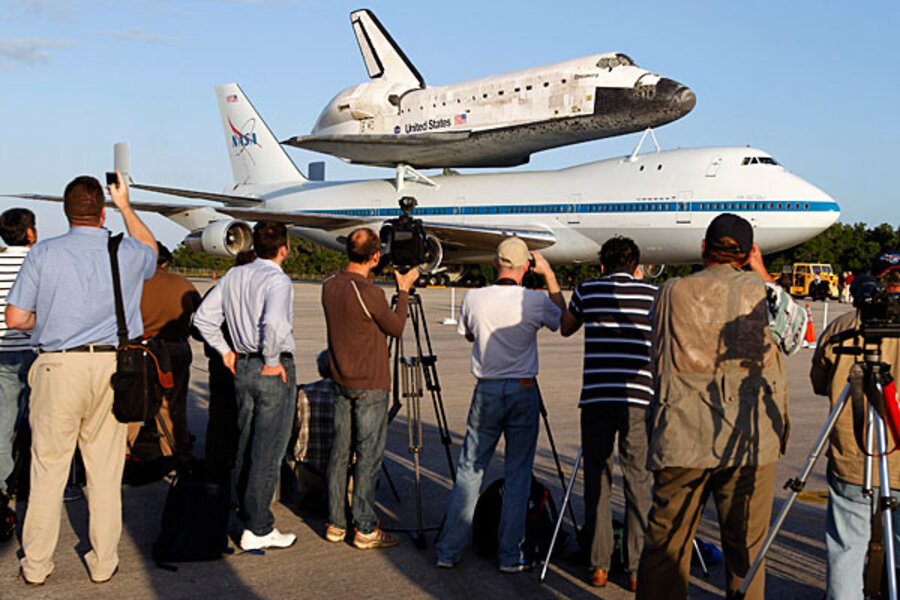Space Shuttle Discovery to swoop over National Mall
Loading...
| Cape Canaveral, Florida
Space shuttle Discovery has one last mission to complete.
At daybreak Tuesday, the oldest of NASA's retired shuttle fleet will leave its home at Kennedy Space Center for the final time, riding on top a modified jumbo jet.
Its destination: the Smithsonian Institution's hangar outside Washington, D.C.
The plane and jet will make a farewell flight over Cape Canaveral before heading north. The pair also will swoop over the nation's capital, including the National Mall, before landing in Virginia.
Space center workers arrived by the busloads Monday at the old shuttle landing strip, where the jet was parked with Discovery bolted on top. Security officers, firefighters, former shuttle workers and even astronauts all posed for pictures in front of Discovery.
The six astronauts who flew Discovery's final space trip a year ago were on hand to bid Discovery goodbye.
Discovery first launched in 1984 and flew 39 times in space, more than any other shuttle. It is the oldest of NASA's three surviving space shuttles and the first to head to a museum.
It will go on display at the Smithsonian's hangar at Dulles International Airport in Virginia, replacing Enterprise, the shuttle prototype that never made it to space but was used in landing tests in the late 1970s. Enterprise is bound for New York City's Intrepid Sea, Air & Space Museum.
"It's good to see her one more time, and it's great that Discovery is going to a good home. Hopefully, millions of people for many, many years to come will go see Discovery," said Steven Lindsey, the last astronaut to command Discovery. "It's also sad ... it's sad to see that the program is over."
NASA ended the shuttle program last summer after 30 years to focus on destinations beyond low-Earth orbit. Lindsey, no longer with NASA, now works in the commercial space industry, helping to develop a successor for launching American astronauts to the International Space Station.
Stephanie Stilson, a NASA manager who is heading up the transition and retirement of the three remainingshuttles, said Discovery looked as though it had just arrived from a ferry trip from the backup landing site in California, as it did so many times in years past.
"To see her like this is quite an amazing sight," Stilson said. "We're finally here" almost an exact year since Discovery launched and landed for good, she noted.
Discovery's list of achievements include delivering the Hubble Space Telescope to orbit, carrying the first Russian cosmonaut to launch on a U.S. spaceship, performing the first rendezvous with the Russian spacestation Mir with the first female shuttle pilot in the cockpit, returning Mercury astronaut John Glenn to orbit, and bringing shuttle flights back to life after the Challenger and Columbia accidents.
A white tail cone covers the three replica main engines at the back end of Discovery, to keep them safe during the ferry flight and provide for better aerodynamics. (Only the nozzles are there, no massive power assemblies.)
The original air lock is on board that spacewalking astronauts used to step out into the vacuum; Discovery is the only shuttle keeping one because it's considered the spacecraft of historic record. The robot arm is already in Virginia and will be placed on side-by-side display.
NASA spent the past year draining all toxic fuels from Discovery and removing unnecessary plumbing.
Stilson said she's managed to keep her emotions in check by staying busy. She's one of the luckier ones; thousands of shuttle workers have lost their jobs.
Astronaut Nicole Stott had "mixed feelings" as she gazed up at Discovery. "There's no denying the sadness associated with it," said Stott, who was on Discovery's last crew.
The newer shuttle Endeavour is promised to the California Science Center in Los Angeles; it ships out in September. Shuttle Atlantis will remain at Kennedy; a huge display area is in works at the visitor complex.
With the shuttles retired, U.S. astronauts are hitching big-bucks rides on Russian Soyuz rockets to get to thespace station. A variety of private American companies are vying for astronaut transportation rights. Officials expect it to be another five years or so before the new spacecraft will be ready to carry passengers.
One of the main competitors, Space Exploration Technologies Corp. or SpaceX, is due to launch its Falcon rocket and Dragon capsule from Cape Canaveral on April 30 with an unprecedented trip to the space station. It will be the first time a private company makes such a cargo run.
Station managers met with SpaceX officials Monday to review the status of the flight.







